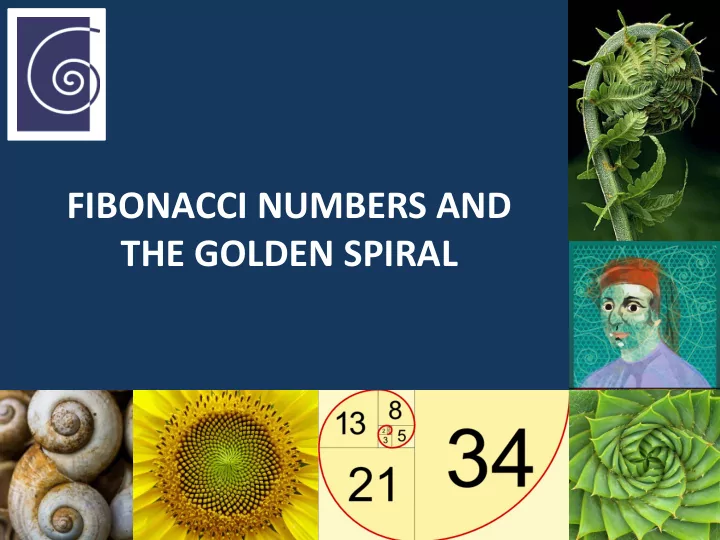

FIBONACCI NUMBERS AND THE GOLDEN SPIRAL
Leonardo Pisano Bigollo (Fibonacci) (c. 1170 – c. 1250) Italian Mathematician Considered by some “the most talented western mathematician of the Middle Ages” Published Liber Abaci (Book of Calculation) in 1202 in which he introduced western mathematics to a mathematic sequence known today as the Fibonacci numbers
Fibonacci did not discover the series but he introduced it to the west in his 1202 book Liber Abaci (Book of Calculation). In his book Fibonacci considered the growth of an unrealistic rabbit population. A newly born rabbit pair, one male and one female, was put into a field. After one month they were able to mate and one month later the female gave birth to another pair of rabbits, a male and a female. The assumption of the idealized rabbit population were that rabbits never die, a rabbit pair could mate one month after birth and would reproduce another pair of rabbits, a male and a female, one month later. Fibonacci wanted to know how many rabbits there would be after one year. At the end of the second month the original female produces another pair making a total of two pairs. At the end of the third month the original female reproduces another pair making a total of three pairs. At the end of the fourth month the original female produces another pair and her first pair reproduces their first pair making a total of five pairs. So how many rabbits will there be at the end of one year?
Pairs ready Reproduction # # Month to procreate Process Pairs Rabbits Now None 1 2 1 1 1+1= 2 4 2 1 2+1= 3 6 3 2 3+2= 5 10 4 3 5+3= 8 16 5 5 8+5= 13 26 6 8 13+8= 21 42 7 13 21+13= 34 68 8 21 34+21= 55 110 9 34 55+34= 89 178 10 55 89+55= 144 288 11 89 144+89= 233 466 12 144 233+144= 377 754
𝒇 𝒚 A single grain of rice doubled every month Amount of rabbits after 1 year 𝒇 𝒚 R1 earning 500% interest continuously compounded Pairs of rabbits after 1 year
THE FIBONACCI SEQUENCE 0, 1, 1, 2, 3, 5, 8, 13, 21, 34, 55, 89, 144, 233, 377, 610, 987, 1597, 2584, 4181, 6765… The sequence starts with 0 and 1, and each subsequent number is the sum of the previous two. Mathematically defined as: Fn = Fn-1 + Fn-2 with seed values F0 = 0, F1 = 1 Squares with sides equal to the Fibonacci numbers place next to each other in a spiral sequence with arcs drawn in the squares with radiuses equal to the sides of the squares connecting the opposite corners of the squares form a spiral known as the golden spiral
89 89 89 89 89 89 89 89 89 89 89 13 13 13 13 13 13 13 13 13 13 13 13 13 13 13 21 21 21 21 21 21 21 21 21 21 21 21 21 21 3 2 3 2 3 2 3 2 3 2 3 2 3 2 3 2 3 2 3 2 3 2 3 2 3 2 3 2 3 2 3 2 3 2 3 2 2 1 1 1 1 1 1 1 1 1 1 1 1 1 1 1 1 1 1 1 1 1 1 1 1 1 1 1 1 1 1 1 1 1 1 1 1 1 1 1 1 1 8 8 8 8 8 8 8 8 8 8 8 8 8 8 8 8 144 144 144 144 144 144 144 144 144 144 5 5 5 5 5 5 5 5 5 5 5 5 5 5 5 5 5 55 55 55 55 55 55 55 55 55 55 55 55 34 34 34 34 34 34 34 34 34 34 34 34 34
THE GOLDEN RATIO Fibonacci nr n F n /F n-1 1/(F n / Fn-1 ) (Fn) 1 0 2 1 3 1 1.0000 1.0000 4 2 2.0000 0.5000 The Fibonacci numbers is closely related to 5 3 1.5000 0.6667 the golden ratio of 1.6180 or its inverse of 6 5 1.6667 0.6000 0.618. 7 8 1.6000 0.6250 The ratio of each Fibonacci number to the 8 13 1.6250 0.6154 previous Fibonacci number resembles the 9 21 1.6154 0.6190 golden ratio; the higher up the sequence, 10 34 1.6190 0.6176 the more closely the ratio of two consecutive Fibonacci numbers will … … … … approach the golden ratio. 51 12586269025 1.6180 0.6180 The Fibonacci number sequence and the 52 20365011074 1.6180 0.6180 golden ratio can be used to describe the 53 32951280099 1.6180 0.6180 proportions of almost everything in nature 54 53316291173 1.6180 0.6180 from the smallest DNA sequence to celestial 55 86267571272 1.6180 0.6180 bodies.
FIBONACCI IN NATURE… 89 13 21 3 2 1 1 8 144 5 55 34
89 13 21 3 2 1 1 8 144 5 55 34
FIBONACCI IN FINANCE Financial markets also seem to conform to the Fibonacci sequence and the golden ratio. Technical analysts have developed some strategies to take advantage of this phenomenon. The golden ratio can be translated into the following percentages: 50%, 61.8% and 38.2% (100% - 61.8%). Additional multiples can also be added. These percentages along with the Fibonacci numbers can be used in technical strategies. The golden ratio and the Fibonacci sequence have been used with numerous successes to analyse and predict stock market moves.
High Resistance Golden Ratio % Support FIBONACCI RETRACEMENTS Low
High Resistance 38.2% Arc 50% Arc 61.8% Arc Support FIBONACCI ARCS Low
Resistance FIBONACCI FANS High 100% Support 38.2% 50% 61.8% Low 0%
89 55 34 21 13 FIBONACCI TIME ZONES 8 5 3 2 1 1
89 13 21 3 2 1 1 8 144 5 55 34
Recommend
More recommend